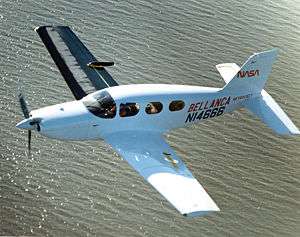Bellanca Skyrocket II
| 19-25 Skyrocket II | |
|---|---|
 | |
| Skyrocket II under aerodynamic evaluation by NASA. | |
| Role | Utility aircraft |
| Manufacturer | Bellanca Aircraft Engineering Inc. |
| First flight | March 1975 |
| Produced | 1 |
The Bellanca 19-25 Skyrocket II was a prototype light airplane built in the United States in the 1970s. Despite its advanced design and exceptionally good performance, it never achieved certification or entered production.
Development
The aircraft was the result of Giuseppe Bellanca's son, August. Bellanca formed Bellanca Aircraft Engineering Inc. company in Scott Depot, West Virginia to develop a new design conceived in 1957.[1] The Skyrocket II was a six-seat, low-wing cantilever monoplane of conventional configuration with retractable tricycle undercarriage. It was constructed of composite materials, an advanced feature for its time, and test flying proved it to be extremely fast in the air. Within months of its first flight, the prototype claimed five world airspeed records for an aircraft in its class, with all but one still standing as of 2013. The aircraft attracted the attention of NASA, which conducted an aerodynamic analysis of the design, in order to investigate natural laminar flow as a factor of its high performance.
Plans to produce the aircraft commercially were scrapped due to the downturn in the civil aviation market in the United States in the early 1980s. In the mid-1990s, the design was developed into a kit and sold as the Skyrocket III to help fund a new certification programme. The Skyrocket III features greater speed, payload and range and was re-engineered for modular construction. By 1998 eleven kits had been delivered, but it is uncertain if any were completed and flown.[2]
Surviving aircraft
The prototype Skyrocket II is owned by the Delaware Aviation Museum in Georgetown, Delaware.[3]
Specifications (Skyrocket II)
Data from Jane's All The World's Aircraft 1976–77[4]
General characteristics
- Crew: one
- Capacity: five passengers
- Length: 28 ft 11 in (8.81 m)
- Wingspan: 35 ft 0 in (10.67 m)
- Height: 9 ft 3 in (2.82 m)
- Wing area: 182.6 sq ft (16.96 m2)
- Aspect ratio: 6.7:1
- Airfoil: NACA 632215
- Empty weight: 2,300 lb (1,043 kg)
- Max takeoff weight: 4,100 lb (1,860 kg)
- Powerplant: 1 × Continental GTSIO-520-F air-cooled flat-six, 435 hp (324 kW)
Performance
- Maximum speed: 331 mph (533 km/h; 288 kn) at 29,000 ft (8,800 m)
- Cruise speed: 255 mph (410 km/h; 222 kn) at 15,000 ft (4,600 m), 65% power
- Stall speed: 65 mph (105 km/h; 56 kn) flaps down
- Range: 1,465 mi (1,273 nmi; 2,358 km)
- Service ceiling: 30,000 ft (9,100 m)
- Rate of climb: 1,900 ft/min (9.7 m/s)
References
| Wikimedia Commons has media related to Bellanca Skyrocket II. |
- ↑ George C Larson (April 1973). "Whatever Happened to August Bellanca". Flying Magazine: 51.
- ↑ Purdy, Don: AeroCrafter - Homebuilt Aircraft Sourcebook, Fifth Edition, page 120. BAI Communications, 15 July 1998. ISBN 0-9636409-4-1
- ↑ "Bellanca Skyrocket II". Delaware Aviation Museum. Delaware Aviation Museum Foundation. Retrieved 30 January 2018.
- ↑ Taylor 1976, pp. 237–238.
- Taylor, John W. R., ed. (1976). Jane's All The World's Aircraft 1976–77. London: Jane's Yearbooks. ISBN 0-354-00538-3.
- Taylor, Michael J. H. (1989). Jane's Encyclopedia of Aviation. London: Studio Editions. p. 152.
- "Bellanca SkyRocket back on launch pad" Flight International April 12, 1996.
- Wynbrandt, James. "AviaBellanca SkyRocket gets Orenda power" General Aviation News August 7, 1998.
- manufacturer's website
- Fédération Aéronautique Internationale records page for this aircraft
- Summary of NASA test programme